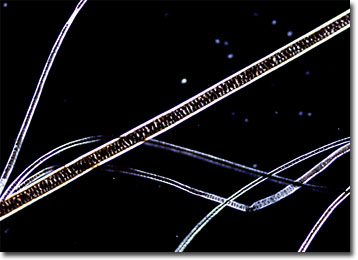Polarized Light Microscopy Digital Image Gallery
Chipmunk Hair
Members of the squirrel family Sciuridae, chipmunks are primarily terrestrial animals, although they are good climbers. Two different genera of these rodents have been identified, containing a combined 26 species, some of which have recently gained popularity as pets.

The chipmunks that inhabit the eastern portion of the United States as well as southeastern Canada belong to the genus Tamias. The common variety is Tamias striatus, which is covered in reddish brown fur highlighted along the back and tail by multiple dark and light stripes. This species generally inhabits the understories of deciduous forests, making its home in underground burrows. In the northern reaches of its range, the common eastern chipmunk may enter a near-hibernation state where its body temperature drops considerably, but since the rodent possesses a short supply of fat, it must periodically become active in order to consume food.
Ensuring an adequate supply of food for the winter is one of the primary activities carried out by chipmunks. Among the many items they often consume are nuts, berries, grains, insects, and the tender shoots of plants. Such edibles are usually stored in their distensible internal check pouches and transported to the protection of the burrow for consumption or storage. Mating takes place in the spring, and following a gestation period of 31 days, females give birth to litters of two to eight young. In some areas, a second litter may be produced late in the summer.
